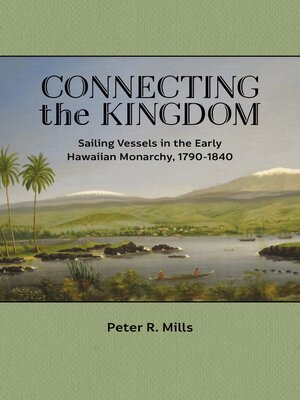Connecting the Kingdom
ebook ∣ Sailing Vessels in the Early Hawaiian Monarchy, 1790–1840
By Peter R. Mills

Sign up to save your library
With an OverDrive account, you can save your favorite libraries for at-a-glance information about availability. Find out more about OverDrive accounts.
Find this title in Libby, the library reading app by OverDrive.



Search for a digital library with this title
Title found at these libraries:
| Loading... |
In this groundbreaking work, Peter Mills reveals a wealth of insight into the emergence of the Hawaiian nation-state from sources mostly ignored by colonial and post-colonial historians alike. By examining how early Hawaiian chiefs appropriated Western sailing technology to help build their island nation, Mills presents the fascinating history of sixty Hawaiian-owned schooners, brigs, barks, and peleleu canoes. While these vessels have often been dismissed as examples of chiefly folly, Mills highlights their significance in Hawaiʻi's rapidly evolving monarchy, and aptly demonstrates how the monarchy's own nineteenth-century sailing fleet facilitated fundamental transformations of interisland tributary systems, alliance building, exchange systems, and emergent forms of Indigenous capitalism.
Part One covers broad trends in Hawaiʻi's changing maritime traditions, beginning with the evolution of Hawaiian archaic states in the precontact era. Mills argues that Indigenous trends towards political intensification under the predecessors to Kamehameha I set the stage for Kamehameha's own rapid appropriation of Western sailing vessels. From the first procurement of a Western-style vessel in 1790 through the beginning of the constitutional monarchy in 1840, these vessels were part of a nuanced strategy that promoted a diverse revenue base for the monarchy and developed greater international parity in Hawaiʻi's foreign diplomacy.
Part Two presents the histories of the sixty vessels owned by Hawaiian chiefs between 1790 and 1840, discussing their significance, origin, physical attributes, ownership, procurement, and purpose. Using newspapers and other contemporaneous sources, Mills uncovers little-known details of more than 2,000 voyages around and between the islands and to distant parts of the Pacific. His meticulous documentation of each ship's itinerary is a valuable resource for tracking the movement of chiefs and commoners between islands as they engaged in the business of building a newly interconnected Hawaiian nation.
Part Three connects these previously neglected maritime stories with an expanding body of historical treatments of Hawaiian agency. Readers with enthusiasm for life in nineteenth-century Hawaiʻi will appreciate the entertaining and, at times, deeply moving glimpses into the daily lives of individuals in Hawaiʻi's pluralistic port communities.






